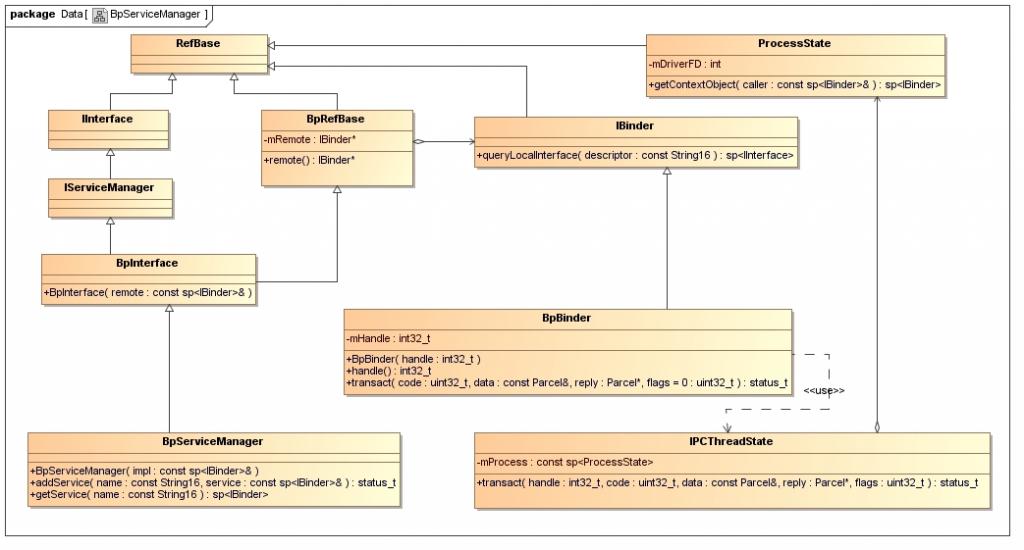原文出处——>[浅谈Android系统进程间通信(IPC)机制Binder中的Server和Client获得Service Manager接口之路](http://blog.csdn.net/luoshengyang/article/details/6627260)
在前面一篇文章浅谈Service Manager成为Android进程间通信(IPC)机制Binder守护进程之路中,介绍了Service Manager是如何成为Binder机制的守护进程的。既然作为守护进程,Service Manager的职责当然就是为Server和Client服务了。那么,Server和Client如何获得Service Manager接口,进而享受它提供的服务呢?本文将简要分析Server和Client获得Service Manager的过程。
在阅读本文之前,希望读者先阅读Android进程间通信(IPC)机制Binder简要介绍和学习计划一文提到的参考资料Android深入浅出之Binder机制,这样可以加深对本文的理解。
我们知道,Service Manager在Binder机制中既充当守护进程的角色,同时它也充当着Server角色,然而它又与一般的Server不一样。对于普通的Server来说,Client如果想要获得Server的远程接口,那么必须通过Service Manager远程接口提供的getService接口来获得,这本身就是一个使用Binder机制来进行进程间通信的过程。而对于Service Manager这个Server来说,Client如果想要获得Service Manager远程接口,却不必通过进程间通信机制来获得,因为Service Manager远程接口是一个特殊的Binder引用,它的引用句柄一定是0。
获取Service Manager远程接口的函数是defaultServiceManager,这个函数声明在frameworks/base/include/binder/IServiceManager.h文件中:
~~~
sp<IServiceManager> defaultServiceManager();
~~~
实现在frameworks/base/libs/binder/IServiceManager.cpp文件中:
~~~
sp<IServiceManager> defaultServiceManager()
{
if (gDefaultServiceManager != NULL) return gDefaultServiceManager;
{
AutoMutex _l(gDefaultServiceManagerLock);
if (gDefaultServiceManager == NULL) {
gDefaultServiceManager = interface_cast<IServiceManager>(
ProcessState::self()->getContextObject(NULL));
}
}
return gDefaultServiceManager;
}
~~~
gDefaultServiceManagerLock和gDefaultServiceManager是全局变量,定义在frameworks/base/libs/binder/Static.cpp文件中:
~~~
Mutex gDefaultServiceManagerLock;
sp<IServiceManager> gDefaultServiceManager;
~~~
从这个函数可以看出,gDefaultServiceManager是单例模式,调用defaultServiceManager函数时,如果gDefaultServiceManager已经创建,则直接返回,否则通过`interface_cast<IServiceManager>(ProcessState::self()->getContextObject(NULL))`来创建一个,并保存在gDefaultServiceManager全局变量中。
在继续介绍`interface_cast<IServiceManager>(ProcessState::self()->getContextObject(NULL))`的实现之前,先来看一个类图,这能够帮助我们了解Service Manager远程接口的创建过程。

参考资料Android深入浅出之Binder机制一文的读者,应该会比较容易理解这个图。这个图表明了,BpServiceManager类继承了`BpInterface<IServiceManager>`类,BpInterface是一个模板类,它定义在**frameworks/base/include/binder/IInterface.h**文件中:
~~~
template<typename INTERFACE>
class BpInterface : public INTERFACE, public BpRefBase
{
public:
BpInterface(const sp<IBinder>& remote);
protected:
virtual IBinder* onAsBinder();
};
~~~
IServiceManager类继承了IInterface类,而IInterface类和BpRefBase类又分别继承了RefBase类。在BpRefBase类中,有一个成员变量mRemote,它的类型是IBinder*,实现类为BpBinder,它表示一个Binder引用,引用句柄值保存在BpBinder类的mHandle成员变量中。BpBinder类通过IPCThreadState类来和Binder驱动程序并互,而IPCThreadState又通过它的成员变量mProcess来打开/dev/binder设备文件,mProcess成员变量的类型为ProcessState。ProcessState类打开设备/dev/binder之后,将打开文件描述符保存在mDriverFD成员变量中,以供后续使用。
理解了这些概念之后,就可以继续分析创建Service Manager远程接口的过程了,最终目的是要创建一个BpServiceManager实例,并且返回它的IServiceManager接口。创建Service Manager远程接口主要是下面语句:
~~~
gDefaultServiceManager = interface_cast<IServiceManager>(
ProcessState::self()->getContextObject(NULL));
~~~
看起来简短,却暗藏玄机,具体可阅读Android深入浅出之Binder机制这篇参考资料,这里作简要描述。
首先是调用ProcessState::self函数,self函数是ProcessState的静态成员函数,它的作用是返回一个全局唯一的ProcessState实例变量,就是单例模式了,这个变量名为gProcess。如果gProcess尚未创建,就会执行创建操作,在ProcessState的构造函数中,会通过open文件操作函数打开设备文件/dev/binder,并且返回来的设备文件描述符保存在成员变量mDriverFD中。
接着调用gProcess->getContextObject函数来获得一个句柄值为0的Binder引用,即BpBinder了,于是创建Service Manager远程接口的语句可以简化为:
~~~
gDefaultServiceManager = interface_cast<IServiceManager>(new BpBinder(0));
~~~
再来看函数`interface_cast<IServiceManager>`的实现,它是一个模板函数,定义在**framework/base/include/binder/IInterface.h**文件中:
~~~
template<typename INTERFACE>
inline sp<INTERFACE> interface_cast(const sp<IBinder>& obj)
{
return INTERFACE::asInterface(obj);
}
~~~
这里的INTERFACE是IServiceManager,于是调用了IServiceManager::asInterface函数。IServiceManager::asInterface是通过DECLARE_META_INTERFACE(ServiceManager)宏在IServiceManager类中声明的,它位于framework/base/include/binder/IServiceManager.h文件中:
~~~
DECLARE_META_INTERFACE(ServiceManager);
~~~
展开即为:
~~~
#define DECLARE_META_INTERFACE(ServiceManager) \
static const android::String16 descriptor; \
static android::sp<IServiceManager> asInterface( \
const android::sp<android::IBinder>& obj); \
virtual const android::String16& getInterfaceDescriptor() const; \
IServiceManager(); \
virtual ~IServiceManager();
~~~
IServiceManager::asInterface的实现是通过IMPLEMENT_META_INTERFACE(ServiceManager, "android.os.IServiceManager")宏定义的,它位于framework/base/libs/binder/IServiceManager.cpp文件中:
~~~
IMPLEMENT_META_INTERFACE(ServiceManager, "android.os.IServiceManager");
~~~
展开即为:
~~~
#define IMPLEMENT_META_INTERFACE(ServiceManager, "android.os.IServiceManager") \
const android::String16 IServiceManager::descriptor("android.os.IServiceManager"); \
const android::String16& \
IServiceManager::getInterfaceDescriptor() const { \
return IServiceManager::descriptor; \
} \
android::sp<IServiceManager> IServiceManager::asInterface( \
const android::sp<android::IBinder>& obj) \
{ \
android::sp<IServiceManager> intr; \
if (obj != NULL) { \
intr = static_cast<IServiceManager*>( \
obj->queryLocalInterface( \
IServiceManager::descriptor).get()); \
if (intr == NULL) { \
intr = new BpServiceManager(obj); \
} \
} \
return intr; \
} \
IServiceManager::IServiceManager() { } \
IServiceManager::~IServiceManager() { }
~~~
估计写这段代码的员工是从Microsoft跳槽到Google的。这里我们关注IServiceManager::asInterface的实现:
~~~
android::sp<IServiceManager> IServiceManager::asInterface(const android::sp<android::IBinder>& obj)
{
android::sp<IServiceManager> intr;
if (obj != NULL) {
intr = static_cast<IServiceManager*>(
obj->queryLocalInterface(IServiceManager::descriptor).get());
if (intr == NULL) {
intr = new BpServiceManager(obj);
}
}
return intr;
}
~~~
这里传进来的参数obj就则刚才创建的new BpBinder(0)了,BpBinder类中的成员函数queryLocalInterface继承自基类IBinder,IBinder::queryLocalInterface函数位于framework/base/libs/binder/Binder.cpp文件中:
~~~
sp<IInterface> IBinder::queryLocalInterface(const String16& descriptor)
{
return NULL;
}
~~~
由此可见,在IServiceManager::asInterface函数中,最终会调用下面语句:
~~~
intr = new BpServiceManager(obj);
~~~
即为:
~~~
intr = new BpServiceManager(new BpBinder(0));
~~~
回到defaultServiceManager函数中,最终结果为:
~~~
gDefaultServiceManager = new BpServiceManager(new BpBinder(0));
~~~
这样,Service Manager远程接口就创建完成了,它本质上是一个BpServiceManager,包含了一个句柄值为0的Binder引用。
在Android系统的Binder机制中,Server和Client拿到这个Service Manager远程接口之后怎么用呢?
对Server来说,就是调用IServiceManager::addService这个接口来和Binder驱动程序交互了,即调用BpServiceManager::addService 。而BpServiceManager::addService又会调用通过其基类BpRefBase的成员函数remote获得原先创建的BpBinder实例,接着调用BpBinder::transact成员函数。在BpBinder::transact函数中,又会调用IPCThreadState::transact成员函数,这里就是最终与Binder驱动程序交互的地方了。回忆一下前面的类图,IPCThreadState有一个PorcessState类型的成中变量mProcess,而mProcess有一个成员变量mDriverFD,它是设备文件/dev/binder的打开文件描述符,因此,IPCThreadState就相当于间接在拥有了设备文件/dev/binder的打开文件描述符,于是,便可以与Binder驱动程序交互了。
对Client来说,就是调用IServiceManager::getService这个接口来和Binder驱动程序交互了。具体过程上述Server使用Service Manager的方法是一样的,这里就不再累述了。
IServiceManager::addService和IServiceManager::getService这两个函数的具体实现,在下面两篇文章中,会深入到Binder驱动程序这一层,进行详细的源代码分析,以便更好地理解Binder进程间通信机制,敬请关注。
- 前言
- Android组件设计思想
- Android源代码开发和调试环境搭建
- Android源代码下载和编译
- Android源代码情景分析法
- Android源代码调试分析法
- 手把手教你为手机编译ROM
- 在Ubuntu上下载、编译和安装Android最新源代码
- 在Ubuntu上下载、编译和安装Android最新内核源代码(Linux Kernel)
- 如何单独编译Android源代码中的模块
- 在Ubuntu上为Android系统编写Linux内核驱动程序
- 在Ubuntu上为Android系统内置C可执行程序测试Linux内核驱动程序
- 在Ubuntu上为Android增加硬件抽象层(HAL)模块访问Linux内核驱动程序
- 在Ubuntu为Android硬件抽象层(HAL)模块编写JNI方法提供Java访问硬件服务接口
- 在Ubuntu上为Android系统的Application Frameworks层增加硬件访问服务
- 在Ubuntu上为Android系统内置Java应用程序测试Application Frameworks层的硬件服务
- Android源代码仓库及其管理工具Repo分析
- Android编译系统简要介绍和学习计划
- Android编译系统环境初始化过程分析
- Android源代码编译命令m/mm/mmm/make分析
- Android系统镜像文件的打包过程分析
- 从CM刷机过程和原理分析Android系统结构
- Android系统架构概述
- Android系统整体架构
- android专用驱动
- Android硬件抽象层HAL
- Android应用程序组件
- Android应用程序框架
- Android用户界面架构
- Android虚拟机之Dalvik虚拟机
- Android硬件抽象层
- Android硬件抽象层(HAL)概要介绍和学习计划
- Android专用驱动
- Android Logger驱动系统
- Android日志系统驱动程序Logger源代码分析
- Android应用程序框架层和系统运行库层日志系统源代码分析
- Android日志系统Logcat源代码简要分析
- Android Binder驱动系统
- Android进程间通信(IPC)机制Binder简要介绍和学习计划
- 浅谈Service Manager成为Android进程间通信(IPC)机制Binder守护进程之路
- 浅谈Android系统进程间通信(IPC)机制Binder中的Server和Client获得Service Manager接口之路
- Android系统进程间通信(IPC)机制Binder中的Server启动过程源代码分析
- Android系统进程间通信(IPC)机制Binder中的Client获得Server远程接口过程源代码分析
- Android系统进程间通信Binder机制在应用程序框架层的Java接口源代码分析
- Android Ashmem驱动系统
- Android系统匿名共享内存Ashmem(Anonymous Shared Memory)简要介绍和学习计划
- Android系统匿名共享内存Ashmem(Anonymous Shared Memory)驱动程序源代码分析
- Android系统匿名共享内存Ashmem(Anonymous Shared Memory)在进程间共享的原理分析
- Android系统匿名共享内存(Anonymous Shared Memory)C++调用接口分析
- Android应用程序进程管理
- Android应用程序进程启动过程的源代码分析
- Android系统进程Zygote启动过程的源代码分析
- Android系统默认Home应用程序(Launcher)的启动过程源代码分析
- Android应用程序消息机制
- Android应用程序消息处理机制(Looper、Handler)分析
- Android应用程序线程消息循环模型分析
- Android应用程序输入事件分发和处理机制
- Android应用程序键盘(Keyboard)消息处理机制分析
- Android应用程序UI架构
- Android系统的开机画面显示过程分析
- Android帧缓冲区(Frame Buffer)硬件抽象层(HAL)模块Gralloc的实现原理分析
- SurfaceFlinger
- Android系统Surface机制的SurfaceFlinger服务
- SurfaceFlinger服务简要介绍和学习计划
- 启动过程分析
- 对帧缓冲区(Frame Buffer)的管理分析
- 线程模型分析
- 渲染应用程序UI的过程分析
- Android应用程序与SurfaceFlinger服务的关系
- 概述和学习计划
- 连接过程分析
- 共享UI元数据(SharedClient)的创建过程分析
- 创建Surface的过程分析
- 渲染Surface的过程分析
- Android应用程序窗口(Activity)
- 实现框架简要介绍和学习计划
- 运行上下文环境(Context)的创建过程分析
- 窗口对象(Window)的创建过程分析
- 视图对象(View)的创建过程分析
- 与WindowManagerService服务的连接过程分析
- 绘图表面(Surface)的创建过程分析
- 测量(Measure)、布局(Layout)和绘制(Draw)过程分析
- WindowManagerService
- WindowManagerService的简要介绍和学习计划
- 计算Activity窗口大小的过程分析
- 对窗口的组织方式分析
- 对输入法窗口(Input Method Window)的管理分析
- 对壁纸窗口(Wallpaper Window)的管理分析
- 计算窗口Z轴位置的过程分析
- 显示Activity组件的启动窗口(Starting Window)的过程分析
- 切换Activity窗口(App Transition)的过程分析
- 显示窗口动画的原理分析
- Android控件TextView的实现原理分析
- Android视图SurfaceView的实现原理分析
- Android应用程序UI硬件加速渲染
- 简要介绍和学习计划
- 环境初始化过程分析
- 预加载资源地图集服务(Asset Atlas Service)分析
- Display List构建过程分析
- Display List渲染过程分析
- 动画执行过程分析
- Android应用程序资源管理框架
- Android资源管理框架(Asset Manager)
- Asset Manager 简要介绍和学习计划
- 编译和打包过程分析
- Asset Manager的创建过程分析
- 查找过程分析
- Dalvik虚拟机和ART虚拟机
- Dalvik虚拟机
- Dalvik虚拟机简要介绍和学习计划
- Dalvik虚拟机的启动过程分析
- Dalvik虚拟机的运行过程分析
- Dalvik虚拟机JNI方法的注册过程分析
- Dalvik虚拟机进程和线程的创建过程分析
- Dalvik虚拟机垃圾收集机制简要介绍和学习计划
- Dalvik虚拟机Java堆创建过程分析
- Dalvik虚拟机为新创建对象分配内存的过程分析
- Dalvik虚拟机垃圾收集(GC)过程分析
- ART虚拟机
- Android ART运行时无缝替换Dalvik虚拟机的过程分析
- Android运行时ART简要介绍和学习计划
- Android运行时ART加载OAT文件的过程分析
- Android运行时ART加载类和方法的过程分析
- Android运行时ART执行类方法的过程分析
- ART运行时垃圾收集机制简要介绍和学习计划
- ART运行时Java堆创建过程分析
- ART运行时为新创建对象分配内存的过程分析
- ART运行时垃圾收集(GC)过程分析
- ART运行时Compacting GC简要介绍和学习计划
- ART运行时Compacting GC堆创建过程分析
- ART运行时Compacting GC为新创建对象分配内存的过程分析
- ART运行时Semi-Space(SS)和Generational Semi-Space(GSS)GC执行过程分析
- ART运行时Mark-Compact( MC)GC执行过程分析
- ART运行时Foreground GC和Background GC切换过程分析
- Android安全机制
- SEAndroid安全机制简要介绍和学习计划
- SEAndroid安全机制框架分析
- SEAndroid安全机制中的文件安全上下文关联分析
- SEAndroid安全机制中的进程安全上下文关联分析
- SEAndroid安全机制对Android属性访问的保护分析
- SEAndroid安全机制对Binder IPC的保护分析
- 从NDK在非Root手机上的调试原理探讨Android的安全机制
- APK防反编译
- Android视频硬解稳定性问题探讨和处理
- Android系统的智能指针(轻量级指针、强指针和弱指针)的实现原理分析
- Android应用程序安装过程源代码分析
- Android应用程序启动过程源代码分析
- 四大组件源代码分析
- Activity
- Android应用程序的Activity启动过程简要介绍和学习计划
- Android应用程序内部启动Activity过程(startActivity)的源代码分析
- 解开Android应用程序组件Activity的"singleTask"之谜
- Android应用程序在新的进程中启动新的Activity的方法和过程分析
- Service
- Android应用程序绑定服务(bindService)的过程源代码分析
- ContentProvider
- Android应用程序组件Content Provider简要介绍和学习计划
- Android应用程序组件Content Provider应用实例
- Android应用程序组件Content Provider的启动过程源代码分析
- Android应用程序组件Content Provider在应用程序之间共享数据的原理分析
- Android应用程序组件Content Provider的共享数据更新通知机制分析
- BroadcastReceiver
- Android系统中的广播(Broadcast)机制简要介绍和学习计划
- Android应用程序注册广播接收器(registerReceiver)的过程分析
- Android应用程序发送广播(sendBroadcast)的过程分析
